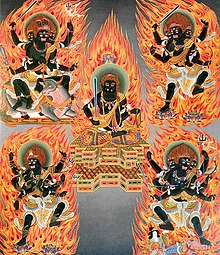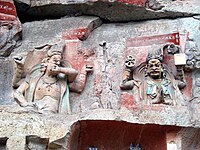Wisdom King
This article relies largely or entirely on a single source. (April 2011) |

| Part of a series on |
| Vajrayana Buddhism |
|---|
 |
In Vajrayana Buddhism, a Wisdom King (Sanskrit Vidyārāja, Chinese: 明王; pinyin: Míngwáng; Japanese pronunciation: Myōō) is a type of deity in Chinese, Japanese and Tibetan Buddhism. They are classed as the third after buddhas and Bodhisattvas in Japanese statuary. The Sanskrit name literally translates to "knowledge king", thus the Chinese character "明", meaning "knowledgeable", or "bright" is used, leading to wide array of alternative English names, including "Radiant King", "Guardian King", etc. In Tibetan Buddhism, they are known as Herukas.
The female counterparts of Wisdom Kings are known as Wisdom Queens (Sanskrit: vidyā-rājñī, Chinese: 明妃 Míngfēi, Japanese: 明妃 Myōhi).
Doctrine[]
Generally, the Wisdom Kings function as the guardians of Buddhism, and wrathful manifestations of Buddhas. More specifically, they are the protectors of the Five Wisdom Buddhas.[1]
According to the esoteric doctrine of the three chakra bodies (三輪身, sanrinjin), whereas Buddhas represent pure concepts and bodhisattvas teach through compassion, Wisdom Kings are embodiments of the wheel of injunction (教令輪身, kyōryō tenshin) and teach through fear, shocking nonbelievers into faith.[1]
Iconography[]
As mentioned above, Wisdom Kings are usually represented as wrathful deities, often with blue skin, multiple arms, sometimes with many faces, and even many legs. They hold weapons in their hands and are sometimes adorned with skulls, snakes or animal skins and wreathed in flames.
List of Wisdom Kings[]
The Five Wisdom Kings[]
In Chinese Esoteric Buddhism and the Japanese Shingon tradition, the Five Great Wisdom Kings (五大明王, Jp: Godai Myō-ō;[2] Ch: Wǔ Dà Míngwáng), also known as the Five Guardian Kings are a group of Wisdom Kings who represent the luminescent wisdom of the Buddha and protect the Five Wisdom Buddhas. The Five Kings are usually defined as follows.

- Acala (不動明王, Jp: Fudō Myō-ō; Ch: Bùdòng Míngwáng) "The Immovable One" - Wrathful manifestation of Buddha Mahavairocana
- Trailokyavijaya (降三世明王, Jp: Gozanze Myō-ō; Ch: Xiángsānshì Míngwáng) "The Conqueror of The Three Planes" - Wrathful manifestation of Buddha Akshobhya
- Kuṇḍali (軍荼利明王, Jp: Gundari Myō-ō; Ch: Jūntúlì Míngwáng) "The Dispenser of Heavenly Nectar" - Wrathful manifestation of Buddha Ratnasambhava
- Yamāntaka (大威德明王, Jp: Daiitoku Myō-ō; Ch: Dàwēidé Míngwáng) "The Defeater of Death" - Wrathful manifestation of Buddha Amitābha[3]
- Vajrayakṣa (金剛夜叉明王, Jp: Kongōyasha Myō-ō; Ch: Jīngāng Yèchā Míngwáng) "The Devourer of Demons" - Wrathful manifestation of Buddha Amoghasiddhi
The Five Wisdom Kings inhabit the Womb Realm. They are organized according to the directions of the compass.
| Vajrayakṣa
(north) |
||
| Yamāntaka
(west) |
Acala
(principal deity/ meditator) |
Trailokyavijaya
(east) |
| Kuṇḍali
(south) |
The Eight Wisdom Kings[]
In Chinese Buddhism, the Eight Great Wisdom Kings (Chinese: 八大明王; Pinyin: Bādà míngwáng), is another grouping of Wisdom Kings that is depicted in statues, mural art and paintings. The acknowledged canonical source of the grouping of eight is the Arya Manjushrimulakalpa (Chinese: 大方廣菩薩藏文殊舍利根本儀軌經; Pinyin: Dà fāngguǎng Púsà Zàng Wénshūshèlì Gēnběn Yíguǐ Jīng; "The Fundamental Ordinance of Manjushri"), an encyclopedic work on iconography, ritual, and even astrological lore, whose Chinese translation in about 980 - 1000 CE is attributed to the monk Tianxizai, who is possibly the north Indian Shantideva.[4] Each of the Wisdom Kings correspond to one of the zh] in Chinese Buddhism as well as to a specific compass direction.
The Eight Wisdom Kings, with exceptions in certain lists, are usually defined as:[5]
- Acala (不動明王; Ch: Bùdòng Míngwáng) "The Immovable One" - Wrathful manifestation of the Bodhisattva Sarvanivāraṇaviṣkambhin, associated with the north-east.
- Kuṇḍali (軍荼利明王; Ch: Jūntúlì Míngwáng) "The Dispenser of Heavenly Nectar" - Wrathful manifestation of the Bodhisattva Ākāśagarbha, associated with the north-west.
- Trailokyavijaya (降三世明王; Ch: Xiángsānshì Míngwáng) "The Conqueror of The Three Planes" - Wrathful manifestation of the Bodhisattva Vajrapani, associated with the south-east.
- (大輪明王; Ch: Dàlún Míngwáng) "The Great Wheel Vajra Holder" - Wrathful manifestation of the Bodhisattva Maitreya, associated with the south-west.
- (步擲明王; Ch: Bùzhì Míngwáng) "The One who Casts his Steps" - Wrathful manifestation of the Bodhisattva Samantabhadra, associated with the north.
- (無能勝明王; Ch: Wúnéngshēng Míngwáng) "The Undefeatable One" - Wrathful manifestation of the Bodhisattva Kṣitigarbha, associated with the south.
- Yamāntaka (大威德明王; Ch: Dàwēidé Míngwáng) "The Defeater of Death" - Wrathful manifestation of the Bodhisattva Manjusri, associated with the east.
- Hayagriva (馬頭觀音; Ch: Mǎtóu Guānyīn) "The Horse-Headed One" - Wrathful manifestation of the Bodhisattva Avalokiteśvara, or Guanyin, associated with the west.
The Ten Wisdom Kings[]
Another grouping found in certain depictions in Chinese Buddhism is the Ten Great Wisdom Kings (Chinese: 十大明王; Pinyin: Shídà míngwáng). The acknowledged canonical source of the grouping is from The Sutra of the Liturgy for Brilliant Contemplation of the Ten Wrathful Wisdom Kings of the Illusory Net of the Great Yoga Teachings Sutra (Chinese: 佛說幻化網大瑜伽教十忿怒明王大明觀想儀軌經; Pinyin: Fóshuō Huànhuàwǎng Dà yújiājiào Shífènnù Míngwáng Dàmíng Guānxiǎng Yíguǐ Jīng).[6] There are several different groupings of the ten Kings, which differ in the removal and addition of certain Wisdom Kings, as well as attributing some Kings to different Buddhas and Bodhisattvas. In medieval and modern Chinese Buddhist practice, the Ten Kings are regularly invoked in repentance ceremonies, such as the Liberation Rite of Water and Land, where they are offered offerings and intreated to expel evil from the ritual platform.[7][8]
One version of the list of Ten Wisdom Kings is defined as:[9]
- Acala (不動明王; Ch: Bùdòng Míngwáng) "The Immovable One" - Wrathful manifestation of the Bodhisattva Sarvanivāraṇaviṣkambhin.
- Trailokyavijaya (降三世明王; Ch: Xiángsānshì Míngwáng) "The Conqueror of The Three Planes" - Wrathful manifestation of the Bodhisattva Vajrapani.
- (大輪明王; Ch: Dàlún Míngwáng) "The Great Wheel Vajra Holder" - Wrathful manifestation of the Bodhisattva Maitreya.
- (步擲明王; Ch: Bùzhì Míngwáng) "The One who Casts his Steps" - Wrathful manifestation of the Bodhisattva Samantabhadra.
- (無能勝明王; Ch: Wúnéngshēng Míngwáng) "The Undefeatable One" - Wrathful manifestation of the Bodhisattva Kṣitigarbha.
- Yamāntaka (大威德明王; Ch: Dàwēidé Míngwáng) "The Defeater of Death" - Wrathful manifestation of the Buddha Amitabha.
- Hayagriva (馬頭觀音; Ch: Mǎtóu Guānyīn) "The Horse-Headed One" - Wrathful manifestation of the Bodhisattva Avalokiteśvara, or Guanyin.
- (大笑明王; Ch: Dàxiào Míngwáng) "The One of Great Laughter" - Wrathful manifestation of the Bodhisattva Ākāśagarbha.
- Ucchuṣma (穢跡金剛明王; Ch: Huìjì Jīngāng Míngwáng) "The Vajra-being of Impure Traces" - Wrathful manifestation of the Buddha Sakyamuni
- Ucchuṣma (火頭金剛明王; Ch: Huǒtóu Jīngāng Míngwáng) "The Vajra-being of Fire Head" - Wrathful manifestation of the Buddha Mahavairocana (Huìjì Jīngāng and Huǒtóu Jīngāng are sometimes regarded as different manifestations, but more often considered the same manifestation).
Another version of the list is defined as:
- Acala (不動明王; Ch: Bùdòng Míngwáng) "The Immovable One" - Wrathful manifestation of the Bodhisattva Sarvanivāraṇaviṣkambhin.
- Kuṇḍali (軍荼利明王; Ch: Jūntúlì Míngwáng) "The Dispenser of Heavenly Nectar" - Wrathful manifestation of the Buddha Amitabha.
- Trailokyavijaya (降三世明王; Ch: Xiángsānshì Míngwáng) "The Conqueror of The Three Planes" - Wrathful manifestation of the Bodhisattva Vajrapani.
- (大輪明王; Ch: Dàlún Míngwáng) "The Great Wheel Vajra Holder" - Wrathful manifestation of the Bodhisattva Maitreya.
- (步擲明王; Ch: Bùzhì Míngwáng) "The One who Casts his Steps" - Wrathful manifestation of the Bodhisattva Samantabhadra.
- (無能勝明王; Ch: Wúnéngshēng Míngwáng) "The Undefeatable One" - Wrathful manifestation of the Bodhisattva Kṣitigarbha.
- Yamāntaka (大威德明王; Ch: Dàwēidé Míngwáng) "The Defeater of Death" - Wrathful manifestation of the Bodhisattva Manjusri.
- Hayagriva (馬頭觀音; Ch: Mǎtóu Guānyīn) "The Horse-Headed One" - Wrathful manifestation of the Bodhisattva Avalokiteśvara, or Guanyin.
- (大笑明王; Ch: Dàxiào Míngwáng) "The One of Great Laughter" - Wrathful manifestation of the Bodhisattva Ākāśagarbha.
- (大力明王; Ch: Dàlì Míngwáng) "The One of Great Power" - Wrathful manifestation of the Buddha Sakyamuni
Others[]

- Āṭavaka (Chinese: Dàyuánshuài Míngwáng; Japanese: Daigensui Myōō)
- Rāgarāja (Chinese: Àirǎn Míngwáng; Japanese: Aizen Myō'ō)
- Mahāmāyūrī (Chinese: Kǒngquè Míngwáng; Japanese: Kujaku Myōō)
Examples[]
Examples of depictions of the Eight Wisdom Kings can be found at:
- Cliff reliefs and rock carvings at [zh] in Jianchuan,Yunnan
- Statues in the [zh] in Datong, Shanxi
- Frescos in the pagoda at [zh] in Lingqiu, Shanxi
Examples of depictions of the Ten Wisdom Kings can be found at:
- Rock carvings at the Dazu Rock Carving sites in Dazu, Chongqing
- Statues in Shuanglin Temple near Pingyao, Shanxi
- Statues in [zh] in Lantian, Xi'an
- Frescos in Qinglong Temple in Jishan, Shanxi
- Frescos in [zh] in Hunyuan, Shanxi
- Frescos in [zh] in Yanggao, Shanxi
- Frescos in [zh] in Shijiazhuang, Hebei
- Frescos in [zh] in Hunyuan, Shanxi
- Water and Land Ritual paintings from various temples, such as [zh] in Youyu, Shanxi (Currently kept in the Shanxi Museum)
- Documents and carvings from the Mogao Caves near Dunhuang, Gansu
Gallery[]

The Wisdom Kings Ucchusma (Chinese: Huìjì Jīngāng Míngwáng) on the left and Kuṇḍali (Chinese: Jūntúlì Míngwáng) on the right at the Dazu Rock Car

The Wisdom Kings Yamantaka (Chinese: Dàwēidé Míngwáng) on the left and Ucchusma (Chinese: Huǒtóu Jīngāng Míngwáng) on the right at the Dazu Rock Carvings

The Wisdom Kings Hayagriva (Chinese: Mǎtóu Guānyīn) on the left and Trailokyavijaya (Chinese: Xiángsānshì Míngwáng) on the right at the Dazu Rock Carvings

The Wisdom Kings Acalanatha (Chinese: Bùdòng Míngwáng) on the left and Yamantaka (Chinese: Dàwēidé Míngwáng) on the right at the Dazu Rock Carvings

The Wisdom Kings (Chinese: Wúnéngshēng Míngwáng)on the left, (Chinese: Dàlún Míngwáng) in the centre and (Chinese: Bùzhì Míngwáng) on the right at the Dazu Rock Carvings


Vajrabhairava
Acala

Ucchusma
See also[]
- Dharmapāla and Lokapāla, guardian deities
References[]
- ^ Jump up to: a b Baroni, Helen Josephine (2002). The illustrated encyclopedia of Zen Buddhism. New York: Rosen Pub. Group. p. 100. ISBN 0-8239-2240-5.
- ^ Brown, Steven T. (2001), Theatricalities of power: the cultural politics of Noh, Stanford University Press, p. 85, ISBN 0-8047-4070-4
- ^ J. Hackin (1994). Asiatic Mythology: A Detailed Description and Explanation of the Mythologies of All the Great Nations of Asia. Asian Educational Services. p. 423. ISBN 978-81-206-0920-4.
- ^ Howard, Angela F. (1999-03-01). "The Eight Brilliant Kings of Wisdom of Southwest China". Res: Anthropology and Aesthetics. 35: 92–107. doi:10.1086/RESv35n1ms20167019. ISSN 0277-1322. S2CID 164236937. Archived from the original on 2021-08-24. Retrieved 2021-08-24.
- ^ Howard, Angela F. (1999-03-01). "The Eight Brilliant Kings of Wisdom of Southwest China". Res: Anthropology and Aesthetics. 35: 92–107. doi:10.1086/RESv35n1ms20167019. ISSN 0277-1322. S2CID 164236937. Archived from the original on 2021-08-24. Retrieved 2021-08-24.
- ^ Howard, Angela F. (1999-03-01). "The Eight Brilliant Kings of Wisdom of Southwest China". Res: Anthropology and Aesthetics. 35: 92–107. doi:10.1086/RESv35n1ms20167019. ISSN 0277-1322. S2CID 164236937. Archived from the original on 2021-08-24. Retrieved 2021-08-24.
- ^ "Descent of the Deities: The Water-Land Retreat and the Transformation of the Visual Culture of Song-Dynasty (960-1279) Buddhism - ProQuest". www.proquest.com. Archived from the original on 2021-08-29. Retrieved 2021-08-26.
- ^ "The Water -Land Dharma Function Platform ritual and the Great Compassion Repentance ritual - ProQuest". www.proquest.com. Archived from the original on 2021-08-29. Retrieved 2021-08-26.
- ^ Howard, Angela F. (1999-03-01). "The Eight Brilliant Kings of Wisdom of Southwest China". Res: Anthropology and Aesthetics. 35: 92–107. doi:10.1086/RESv35n1ms20167019. ISSN 0277-1322. S2CID 164236937. Archived from the original on 2021-08-24. Retrieved 2021-08-24.
Further reading[]
- Mark and Luebeck,Walter Hosak (2006). Big Book of Reiki Symbols, The. Tokyo: Lotus Press. ISBN 0-914955-64-0.
External links[]
 Media related to Vidyaraja at Wikimedia Commons
Media related to Vidyaraja at Wikimedia Commons
- Wisdom Kings










